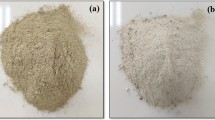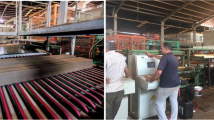Abstract
Within the scope of the present study, the marble cutting waste, which is an industrial waste of different sizes (< 75 µm and < 150 µm), was incorporated into the clay structure at various rates and a total of 36 series bricks were produced. The brick mixtures were prepared by the semi-dry molding method and the brick specimens were sintered for three temperatures (850 °C, 950 °C, and 1050 °C). The fired bricks containing marble cutting waste with a lower particle size (75 µm) have higher compressive strength. However, all samples produced can meet the relevant standard requirements in terms of compressive strength. Thermal conductivity decreased from 1.008 to 0.775 W/mK with the incorporation of marble cutting waste, a decrease of approximately 23.11%. The effects of grain size, firing temperature, and marble cutting waste concentration on the quadratic model were statistically determined by variance analysis (ANOVA). According to statistical findings, the order of importance of design factors for brick properties (except for compressive strength) is marble cutting waste > firing temperature > particle size. For compressive strength, the most dominant factor is amount of marble cutting waste, followed by particle size and firing temperature, respectively. Consequently, the results suggest that marble cutting waste does not need to be reduced to smaller particle sizes to improve the fired clay brick properties.











Similar content being viewed by others
Data availability
Not applicable.
Change history
21 June 2022
A Correction to this paper has been published: https://doi.org/10.1007/s11356-022-21604-0
References
Alyousef R, Benjeddou O, Khadimallah MA, et al (2018) Study of the effects of marble powder amount on the self-compacting concretes properties by microstructure analysis on cement-marble powder pastes. Adv Civ Eng 2018:
Alyousef R, Benjeddou O, Soussi C, et al (2019) Experimental study of new insulation lightweight concrete block floor based on perlite aggregate, natural sand, and sand obtained from marble waste. Adv Mater Sci Eng 2019:
Arsenović M, Radojević Z, Jakšić Ž, Pezo L (2015) Mathematical approach to application of industrial wastes in clay brick production—part I: testing and analysis. Ceram Int 41:4890–4898
Ashish DK, Verma SK, Kumar R, Sharma N (2016) Properties of concrete incorporating sand and cement with waste marble powder. Adv Concr Constr 4:145
ASTM C373 (1994)–Test method for water absorption, bulk density, apparent porosity, and apparent specific gravity of fired white ware products. In: American Society for Testing and Materials
ASTM C (2013) Standard specification for building brick (solid masonry units made from clay or shale)
Baghel R, Pandel U, Vashistha A (2020) Manufacturing of sustainable bricks: utilization of mill scale and marble slurry. Mater Today Proc 26:2136–2139
Barbieri L, Andreola F, Lancellotti I, Taurino R (2013) Management of agricultural biomass wastes: preliminary study on characterization and valorisation in clay matrix bricks. Waste Manag 33:2307–2315
Benjeddou O, Alwetaishi M (2021) Valorization of powder obtained from marble sludge waste and ıts suitability as a mineral filler. Curr Comput-Aided Drug Des 11:619
Benjeddou O, Mashaan N (2022) Experimental study of the usability of recycling marble waste as aggregate for road construction. Sustainability 14:3195
Benjeddou O, Soussi C, Jedidi M, Benali M (2017) Experimental and theoretical study of the effect of the particle size of limestone fillers on the rheology of self-compacting concrete. J Build Eng 10:32–41
ASTM C90 (2014) Standard specification for loadbearing concrete masonry units
Cobo-Ceacero CJ, Cotes-Palomino MT, Martínez-García C et al (2019) Use of marble sludge waste in the manufacture of eco-friendly materials: applying the principles of the circular economy. Environ Sci Pollut Res 26:35399–35410
ASTM D4318 (2000) Standard test method for liquid limit, plastic limit, and plasticity ındex of soils. Am Soc Test Mater
Eliche-Quesada D, Corpas-Iglesias FA, Pérez-Villarejo L, Iglesias-Godino FJ (2012) Recycling of sawdust, spent earth from oil filtration, compost and marble residues for brick manufacturing. Constr Build Mater 34:275–284
Eliche-Quesada D, Felipe-Sesé MA, López-Pérez JA, Infantes-Molina A (2017) Characterization and evaluation of rice husk ash and wood ash in sustainable clay matrix bricks. Ceram Int 43:463–475
Eliche-Quesada D, Leite-Costa J (2016) Use of bottom ash from olive pomace combustion in the production of eco-friendly fired clay bricks. Waste Manag 48:323–333
EN BS (2011) Methods of test for masonry units—part 1: determination of compressive strength
EN BS (2003) Specification for masonry units—part 1: clay masonry units
EN TS (2005) 771–1,Specification for masonry units. Part 1: clay masonry units. Ente Naz Ital di unificazione
Ercikdi B, Külekci G, Yılmaz T (2015) Utilization of granulated marble wastes and waste bricks as mineral admixture in cemented paste backfill of sulphide-rich tailings. Constr Build Mater 93:573–583
Goel G, Kalamdhad AS, Agrawal A (2018) Parameter optimisation for producing fired bricks using organic solid wastes. J Clean Prod 205:836–844
Kazmi SMS, Abbas S, Nehdi ML et al (2017) Feasibility of using waste glass sludge in production of ecofriendly clay bricks. J Mater Civ Eng 29:4017056
Kazmi SMS, Abbas S, Saleem MA et al (2016) Manufacturing of sustainable clay bricks: utilization of waste sugarcane bagasse and rice husk ashes. Constr Build Mater 120:29–41
Khan Z, Gul A, Shah SAA, et al (2021) Utilization of marble wastes in clay bricks: a step towards lightweight energy efficient construction materials. Civ Eng J 7:
Lamba P, Kaur DP, Raj S, Sorout J (2021) Recycling/reuse of plastic waste as construction material for sustainable development: a review. Environ Sci Pollut Res 1–24
Loutou M, Taha Y, Benzaazoua M et al (2019) Valorization of clay by-product from moroccan phosphate mines for the production of fired bricks. J Clean Prod 229:169–179
Mangi SA, Raza MS, Khahro SH, et al (2022) Recycling of ceramic tiles waste and marble waste in sustainable production of concrete: a review. Environ Sci Pollut Res 1–22
Mashaly AO, El-Kaliouby BA, Shalaby BN et al (2016) Effects of marble sludge incorporation on the properties of cement composites and concrete paving blocks. J Clean Prod 112:731–741
Mathieu D, Phan-Tan-Luu R (1997) Approche méthodologique des surfaces de réponse. Plans d’expériences Appl à l’entreprise 211–278
Munir MJ, Abbas S, Nehdi ML et al (2018a) Development of eco-friendly fired clay bricks incorporating recycled marble powder. J Mater Civ Eng 30:4018069
Munir MJ, Kazmi SMS, Wu Y-F et al (2018b) Thermally efficient fired clay bricks incorporating waste marble sludge: an industrial-scale study. J Clean Prod 174:1122–1135
Muñoz P, Mendívil MA, Letelier V, Morales MP (2019) Thermal and mechanical properties of fired clay bricks made by using grapevine shoots as pore forming agent. Influence of particle size and percentage of replacement. Constr Build Mater 224:639–658
Nigay P-M, Sani R, Cutard T, Nzihou A (2017) Modeling of the thermal and mechanical properties of clay ceramics incorporating organic additives. Mater Sci Eng A 708:375–382
Njoya D, Hajjaji M, Njopwouo D (2012) Effects of some processing factors on technical properties of a clay-based ceramic material. Appl Clay Sci 65:106–113
Rashwan MA, Al-Basiony TM, Mashaly AO, Khalil MM (2020) Behaviour of fresh and hardened concrete incorporating marble and granite sludge as cement replacement. J Build Eng 32:101697
Romero M, Andrés A, Alonso R et al (2008) Sintering behaviour of ceramic bodies from contaminated marine sediments. Ceram Int 34:1917–1924
Sabino TPF, Coelho NPF, Andrade NC, et al (2021) Lignocellulosic materials as soil–cement brick reinforcement. Environ Sci Pollut Res 1–20
Saboya F Jr, Xavier GC, Alexandre J (2007) The use of the powder marble by-product to enhance the properties of brick ceramic. Constr Build Mater 21:1950–1960
Sardinha M, de Brito J, Rodrigues R (2016) Durability properties of structural concrete containing very fine aggregates of marble sludge. Constr Build Mater 119:45–52
Singh M, Srivastava A, Bhunia D (2017) An investigation on effect of partial replacement of cement by waste marble slurry. Constr Build Mater 134:471–488
Sutcu M, Alptekin H, Erdogmus E et al (2015) Characteristics of fired clay bricks with waste marble powder addition as building materials. Constr Build Mater 82:1–8
Todor DN (1976) Thermal analysis of minerals. Abacus press
Tozsin G, Oztas T, Arol AI et al (2014) The effects of marble wastes on soil properties and hazelnut yield. J Clean Prod 81:146–149
Weng C-H, Lin D-F, Chiang P-C (2003) Utilization of sludge as brick materials. Adv Environ Res 7:679–685
Yaras A (2020) Combined effects of paper mill sludge and carbonation sludge on characteristics of fired clay bricks. Constr Build Mater 249:118722
Yaras A, Sutcu M, Gencel O, Erdogmus E (2019) Use of carbonation sludge in clay based building materials processing for eco-friendly, lightweight and thermal insulation. Constr Build Mater 224:57–65
Zhang M, Chen C, Mao L, Wu Q (2018) Use of electroplating sludge in production of fired clay bricks: characterization and environmental risk evaluation. Constr Build Mater 159:27–36
Funding
This study was supported by the Bartın University Scientific Research Projects Coordination Office (grant ID 2020-FEN-B-008).
Author information
Authors and Affiliations
Contributions
Ertugrul Erdogmus: investigation, visualization, experimental supervision. Ali Yaras: conceptualization, writing — original draft, experimental supervision. Mucahit Sutcu: investigation, data curation, methodology. Osman Gencel: conceptualization, writing — review and editing.
Corresponding author
Ethics declarations
Ethics approval
Not applicable.
Consent to participate
Not applicable.
Consent for publication
Not applicable.
Conflict of interest
The authors declare no competing interests.
Additional information
Responsible Editor: Philippe Garrigues
Publisher's Note
Springer Nature remains neutral with regard to jurisdictional claims in published maps and institutional affiliations.
The original online version of this article was revised: Equation 4 is duplicated. The correct Equation 5 is shown in the revised published proof.
Rights and permissions
About this article
Cite this article
Erdogmus, E., Yaras, A., Sutcu, M. et al. Recycling of marble cutting waste additives in fired clay brick structure: a statistical approach to process parameters. Environ Sci Pollut Res 29, 71936–71947 (2022). https://doi.org/10.1007/s11356-022-20651-x
Received:
Accepted:
Published:
Issue Date:
DOI: https://doi.org/10.1007/s11356-022-20651-x




